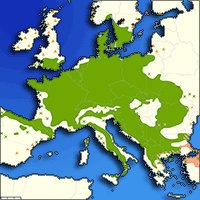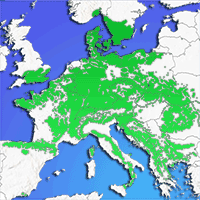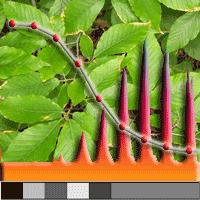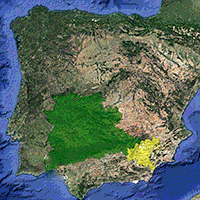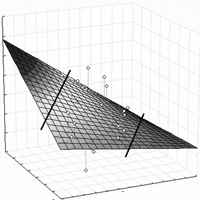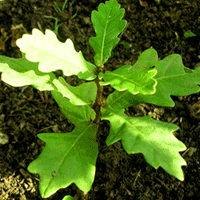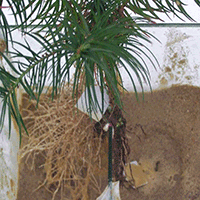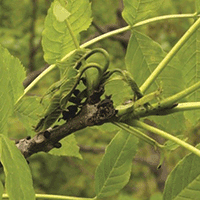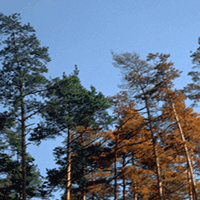Through a common garden (provenance) experiment, we investigated the metabolic responses to climatic stress with regard to the acclimation potential of different European beech (Fagus sylvatica L.) populations. Selected enzymatic and non-enzymatic antioxidants were analyzed in leaves. Peroxidase (POD) and polyphenol oxidase (PPO) enzyme activity, total protein content as well as ABTS [2.2’-azino-bis-(3-etylbenzothiazoline)-6-sulphonic acid] antioxidant capacity were measured in the leaves of selected populations. Major leaf polyphenols were identified and their relative amounts were compared. Significant correlations were found between phenotypic (diameter growth) response to simulated climatic stress and the activity (and amount) of selected chemical components. The concentrations of certain polyphenols, POD enzyme activity, and total protein content may be chemical indicators of the acclimation potential of populations and may contribute to the forecasting of climate change effects, which can aid in the selection of suitable propagation material for adaptive silviculture.
Keywords
, , , , ,
Citation
Visi-Rajczi E, Hofmann T, Albert L, Mátyás C (2021). Tracing the acclimation of European beech (Fagus sylvatica L.) populations to climatic stress by analyzing the antioxidant system. iForest 14: 95-103. - doi: 10.3832/ifor3542-013
Academic Editor
Claudia Cocozza
Paper history
Received: Jun 04, 2020
Accepted: Dec 24, 2020
First online: Mar 01, 2021
Publication Date: Apr 30, 2021
Publication Time: 2.23 months
© SISEF - The Italian Society of Silviculture and Forest Ecology 2021
Open Access
This article is distributed under the terms of the Creative Commons Attribution-Non Commercial 4.0 International (https://creativecommons.org/licenses/by-nc/4.0/), which permits unrestricted use, distribution, and reproduction in any medium, provided you give appropriate credit to the original author(s) and the source, provide a link to the Creative Commons license, and indicate if changes were made.

Breakdown by View Type
(Waiting for server response...)
Article Usage
Total Article Views: 36141
(from publication date up to now)
Breakdown by View Type
HTML Page Views: 30538
Abstract Page Views: 2611
PDF Downloads: 2365
Citation/Reference Downloads: 3
XML Downloads: 624
Web Metrics
Days since publication: 1748
Overall contacts: 36141
Avg. contacts per week: 144.73
Article Citations
Article citations are based on data periodically collected from the Clarivate Web of Science web site
(last update: Mar 2025)
Total number of cites (since 2021): 9
Average cites per year: 1.80
Publication Metrics
by Dimensions ©
Articles citing this article
List of the papers citing this article based on CrossRef Cited-by.
(1)
Achmadi SS (2019)Polyphenols resources in Indonesia from economic perspective. In: “Polyphenols in Plants (2nd edn). Isolation, Purification and Extract Preparation” (Watson RR ed). Academic press, San Diego, CA, USA, pp. 67-79.
CrossRef |
Gscholar
(2)
Allen CD, Breshears DD, McDowell NG (2015)On underestimation of global vulnerability to tree mortality and forest die-off from hotter drought in the Anthropocene. Ecosphere 6: 1-55.
CrossRef |
Gscholar
(3)
Aranda I, Sánchez-Gómez D, De Miguel M, Mancha JA, Guevara MA, Cadahía E, Fernández De Simón MB (2017)Fagus sylvatica L. provenances maintain different leaf metabolic profiles and functional response. Acta Oecologica 82: 1-9.
CrossRef |
Gscholar
(4)
Bae JJ, Choo YS, Ono K, Sumida A, Hara T (2010)Photoprotective mechanisms in cold-acclimated and nonacclimated needles of
Picea glehnii. Photosynthetica 48: 110-116.
CrossRef |
Gscholar
(5)
Baniulis D, Sirgediene M, Haimi P, Tamošiune I, Danusevičius D (2020)Constitutive and cold acclimation-regulated protein expression profiles of scots pine seedlings reveal potential for adaptive capacity of geographically distant populations. Forests 11: 89.
CrossRef |
Gscholar
(6)
Berini JL, Brockman SA, Hegeman AD, Reich PB, Muthukrishnan R, Montgomery RA, Forester JD (2018)Combinations of abiotic factors differentially alter production of plant secondary metabolites in five woody plant species in the boreal-temperate transition zone. Frontiers in Plant Science 9: 1257.
CrossRef |
Gscholar
(7)
Berki I, Rasztovits E, Móricz N, Mátyás C (2009)Determination of the drought tolerance limit of beech forests and forecasting their future distribution in Hungary. Cereal Research Communications 37: 613-616.
CrossRef |
Gscholar
(8)
Boughalleb F, Mhamdi M (2011)Possible involvement of proline and the antioxidant defense systems in the drought tolerance of three olive cultivars grown under increasing water deficit regimes. Agricultural Journal 6: 378-391.
CrossRef |
Gscholar
(9)
Bradford MM (1976)A rapid sensitive method for the quantitation of microgram quantities of protein utilising the principle of protein-dye binding. Analytical Biochemistry 72: 248-254.
CrossRef |
Gscholar
(10)
Cadahía E, Fernández De Simón B, Aranda I, Sanz M, Sánchez-Gómez D, Pint E (2015)Non-targeted metabolomic profile of
Fagus sylvatica L. leaves using liquid chromatography with mass spectrometry and gas chromatography with mass spectrometry. Phytochemical Analysis 26: 171-182.
CrossRef |
Gscholar
(11)
Caudullo G, Welk E, San-Miguel-Ayanz J (2017)Chorological maps for the main European woody species. Data in Brief 12: 662-666.
CrossRef |
Gscholar
(12)
Chakhchar A, Lamaoui M, Wahbi S, Ferradous A, El Mousadik A, Ibnsouda-Koraichi S, Filali-Maltouf A, El Modafar C (2015a)Differential drought tolerance of four contrasting
Argania spinosa ecotypes assessed by enzymatic and non-enzymatic antioxidant. International Journal of Recent Scientific Research 6: 3002-3009.
Gscholar
(13)
Chakhchar A, Wahbi S, Lamaoui M, Ferradous A, El Mousadik A, Ibnsouda-Koraichi S, Filali-Maltouf A, El Modafar C (2015b)Physiological and biochemical traits of drought tolerance in Argania spinosa. Journal of Plant Interactions 10: (1) 252-261.
CrossRef |
Gscholar
(14)
Comps B, Thiébault B, Merzeau D, Letouzey J (1990)Allozymic variability in beechwoods (
Fagus sylvatica L.) over Central Europe: spatial differentiation among and within stands. Heredity 65: 407-417.
CrossRef |
Gscholar
(15)
Comps B, Mátyás Cs Geburek J, Letouzey J (1998)Genetic variation in beech populations along the Alps chain and in the Hungarian Basin. Forest Genetics 5: 1-9.
Online |
Gscholar
(16)
Czúcz B, Gálhidy L, Mátyás C (2011)Present and forecasted xeric climatic limits of beech and sessile oak distribution at low altitudes in Central Europe. Annals of Forest Science 68 (1): 99-108.
CrossRef |
Gscholar
(17)
Dalmagro AP, Camargo A, Filho HHS, Valcanaia MM, De Jesus PC, Zeni ALB (2018)Seasonal variation in the antioxidant phytocompounds production from the
Morus nigra leaves. Industrial Crops and Products 123: 323-330.
CrossRef |
Gscholar
(18)
Del Río LA (2015)ROS and RNS in plant physiology: an overview. Journal of Experimental Botany 66 (10): 2827-37.
CrossRef |
Gscholar
(19)
Di Ferdinando M, Brunetti C, Fini A, Tattini M (2012)Chapter 9 - Flavonoids as antioxidants in plants under abiotic stresses. In: “Abiotic Stress Responses in Plants” (Ahmad P, Prasad MNV eds). Springer, New York, USA, pp. 159-179.
CrossRef |
Gscholar
(20)
Dixon RA, Paiva NL (1995)Stress-induced phenylpropanoid metabolism. The Plant Cell 7: 1085-1097.
CrossRef |
Gscholar
(21)
Ellenberg H (1988)Vegetation ecology of Central Europe (4th edn). Cambridge University Press, Cambridge, UK, pp. 731.
CrossRef |
Gscholar
(22)
Feucht W, Treutter D (1999)The role of flavan-3-ols and proanthocyanidins in plant defense. In: “Principles and Practices of Plant Ecology” (Inderjit, Dakshini KMM, Foy CL eds). CRC Press LLC, Boca Raton, FL, USA, pp. 308-332.
Gscholar
(23)
Feucht W, Treutter D, Christ E (1994)Accumulation of flavanols in yellowing beech leaves from forest decline sites. Tree Physiology 14: 403-412.
CrossRef |
Gscholar
(24)
Feucht W, Treutter D, Christ E (1996)Flavanols in grapevine:
in vitro accumulation and defence reactions in shoots. Vitis 35: 113-118.
Gscholar
(25)
Feucht W, Treutter D, Christ E (1997)Role of flavanols in yellowing trees of the Black Forest. Tree Physiology 17: 335-340.
CrossRef |
Gscholar
(26)
Flurkey WH, Jen JJ (1978)Peroxidase and polyphenol oxidase activities in developing peaches. Journal of Food Science 43: 1826-1829.
CrossRef |
Gscholar
(27)
Foyer C, Noctor G (2005)Oxidant and antioxidant signaling in plants: a reevaluation of the concept of oxidative stress in a physiological context. Plant, Cell and Environment 28 (8): 1056-1071.
CrossRef |
Gscholar
(28)
Grace SC, Logan BA (1996)Acclimation of foliar antioxidant systems to growth irradiance in three broad-leaved evergreen species. Plant Physiology 112: 1631-1640.
CrossRef |
Gscholar
(29)
Gupta DK, Palma JM, Corpas FJ (2018)Antioxidants and antioxidant enzymes in higher plants. Springer International Publishing, eBook, 300.
CrossRef |
Gscholar
(30)
Haberer K, Herbinger K, Alexou M, Rennenberg H, Tausz M (2008)Effects of drought and canopy ozone exposure on antioxidants in fine roots of mature European beech (
Fagus sylvatica). Tree Physiology 28: 713-719.
CrossRef |
Gscholar
(31)
Hijmans RJ, Cameron SE, Parra JL, Jones PG, Jarvis A (2005)Very high resolution interpolated climate surfaces for global land areas. International Journal of Climatology 25: 1965-1978.
CrossRef |
Gscholar
(32)
Hofmann T, Albert L, Rétfalvi T, Visi-Rajczi E, Brolly G (2008)TLC analysis of the in vitro reaction of beech (
Fagus sylvatica L.) wood enzyme extract with catechins. Journal of Planar Chromatography 21: 83-88.
CrossRef |
Gscholar
(33)
Hofmann T, Nebehaj E, Albert L (2015)The high-performance liquid chromatography/multistage electrospray mass spectrometric investigation and extraction optimization of beech (
Fagus sylvatica L.) bark polyphenols. Journal of Chromatography A 1393: 96-105.
CrossRef |
Gscholar
(34)
Hofmann T, Tálos-Nebehaj E, Albert L (2017a)Leaf polyphenols as indicators of climatic adaptation of beech (
Fagus sylvatica L.) - an HPLC-MS/MS via MRM approach. International Labmate 42 (3): 12-14.
Online |
Gscholar
(35)
Hofmann T, Tálos-Nebehaj E, Albert L, Németh L (2017b)Antioxidant efficiency of beech (
Fagus sylvatica L.) bark polyphenols assessed by chemometric methods. Industrial Crops and Products 108: 26-35.
CrossRef |
Gscholar
(36)
Horváth A, Mátyás C (2014)Növedékcsökkenés elörevetítése egy bükk származási kísérlet alapján [Estimation of increment decline caused by climate change, based on data of a beech provenance trial]. Erdészettudományi Közlemények 4: 91-99. [in Hungarian with English summary]
Gscholar
(37)
Horváth A, Mátyás C (2016)The decline of vitality caused by increasing drought in a beech provenance trial predicted by juvenile growth. South-east European Forestry 7 (1): 21-28.
CrossRef |
Gscholar
(38)
Isah T (2019)Stress and defense responses in plant secondary metabolites production. Biological Research 52: 39.
CrossRef |
Gscholar
(39)
Kala S, Godara AK (2011)Effect of moisture stress on leaf proteins, proline and free amino acid content in commercial cultivars of
Ziziphus mauritiana. Journal of Scientific Research 55: 65-69.
Gscholar
(40)
Korotaeva N, Romanenko A, Suvorova G, Ivanova MV, Lomovatskaya L, Borovskii G, Voinikov V (2015)Seasonal changes in the content of dehydrins in mesophyll cells of common pine needles. Photosynthesis Research 124: 159-169.
CrossRef |
Gscholar
(41)
Lakatos F, Molnár M (2009)Mass mortality of beech (
Fagus sylvatica L.) in south-west Hungary. Acta Silvatica et Lignaria Hungarica 5: 75-82.
Online |
Gscholar
(42)
Laukkanen H, Haggman H, Kontunen-Soppela S, Hohtola A (1999)Tissue browning of
in vitro cultures of Scots pine: role of peroxidase and polyphenol oxidase. Physiologia Plantarum 106: 337-343.
CrossRef |
Gscholar
(43)
Lee OH, Lee BY, Lee J, Lee H, Son J, Park C, Shetty K, Kim YC (2009)Assessment of phenolics enriched extract and fractions of olive leaves and their antioxidant activities. Bioresource Technology 100: 6107-6113.
CrossRef |
Gscholar
(44)
Li S, Zhou L, Addo-Danso SD, Ding G, Sun M, Wu S, Lin S (2020)Nitrogen supply enhances the physiological resistance of Chinese fir plantlets under polyethylene glycol (PEG)-induced drought stress. Scientific Reports 10: 7509.
CrossRef |
Gscholar
(45)
Linnakoski R, Kasanen R, Dounavi A, Forbes KM (2019)Editorial: forest health under climate change: effects on tree resilience, and pest and pathogen dynamics. Frontiers in Plant Science 10: 1157.
CrossRef |
Gscholar
(46)
Luwe M (1996)Antioxidants in the apoplast and symplast of beech (
Fagus sylvatica L.) leaves: seasonal variations and responses to changing ozone concentrations in air. Plant Cell and Environment 19: 321-328.
CrossRef |
Gscholar
(47)
Mátyás C (1994)Modelling climate change effects with provenance test data. Tree Physiology 14: 797-804.
CrossRef |
Gscholar
(48)
Mátyás C, Berki I, Czúcz B, Gálos B, Móricz N, Rasztovits E (2010)Future of beech in Southeast Europe from the perspective of evolutionary ecology. Acta Silvatica et Lignaria Hungarica 6: 91-110.
Online |
Gscholar
(49)
Münzbergová Z, Latzel V, Surinová M, Hadincová V (2018)DNA methylation as a possible mechanism affecting ability of natural populations to adapt to changing climate. Oikos 128: 124-134.
CrossRef |
Gscholar
(50)
Pedan V, Fischer N, Rohn S (2016)An online NP-HPLC-DPPH method for the determination of the antioxidant activity of condensed polyphenols in cocoa. Food Research International 89 (2): 890-900.
CrossRef |
Gscholar
(51)
Pennycooke JC, Cox S, Stushnoff C (2005)Relationship of cold acclimation, total phenolic content and antioxidant capacity with chilling tolerance in petunia (
Petunia × hybrida). Environmental and Experimental Botany 53 (2): 225-232.
CrossRef |
Gscholar
(52)
Penuelas J, Ogaya R, Boada M, Jump AS (2007)Migration, invasion and decline: changes in recruitment and forest structure in a warming-linked shift of European beech forest in Catalonia (NE Spain). Ecography 30: 829-837.
CrossRef |
Gscholar
(53)
Popovic BM, Stajner D, Zdero-Pavlovic R, Tumbas-Saponjac V, Canadanovic-Brunet J, Orlovic S (2016)Water stress induces changes in polyphenol profile and antioxidant capacity in poplar plants (
Populus spp.). Plant Physiology and Biochemistry 105: 242-250.
CrossRef |
Gscholar
(54)
Pukacki PM, Kaminska-Rozek E (2013)Reactive species, antioxidants and cold tolerance during deacclimation of
Picea abies populations. Acta Physiologiae Plantarum 35: 129-138.
CrossRef |
Gscholar
(55)
Sáenz-Romero C, Kremer A, Nagy L, Ujvári-Jármay E, Ducousso A, Kóczán-Horváth A, Hansen JK, Mátyás C (2019)Common garden comparisons confirm inherited differences in sensitivity to climate change between forest tree species. PeerJ 7: e6213.
CrossRef |
Gscholar
(56)
Selye H (1950)Stress and the general adaptation syndrome. British Medical Journal 4667: 1383-1392.
CrossRef |
Gscholar
(57)
Shannon LM, Kay E, Lew JY (1966)Peroxidase isoenzymes from horseradish roots. Journal of Biological Chemistry 241 (9): 2166-2172.
CrossRef |
Gscholar
(58)
Sies H (1991)Oxidative stress: from basic research to clinical application. The American Journal of Medicine 91 (3C): 31-38.
CrossRef |
Gscholar
(59)
Smirnoff N (2005)Antioxidants and reactive oxygen species in plants. Wiley-Blackwell Publishing Ltd, Oxford, UK, pp. 320.
CrossRef |
Gscholar
(60)
Song YY, Simard SW, Caroll A, Mohn WW, Zheng R (2015)Defoliation of interior Douglas fir elicits carbon transfer and defense signaling to ponderosa pine neighbors through ectomycorrhizal networks. Scientific Reports 5 (8495): 1-9.
CrossRef |
Gscholar
(61)
Stajner D, Orlovic S, Popovic BM, Kebert M, Stojnic S, Klasnja B (2013)Chemical parameters of oxidative stress adaptability in Beech. Journal of Chemistry 2013: 1-8.
CrossRef |
Gscholar
(62)
Stojanovic DB, Kric A, Matovic B, Orlovic S, Duputie A, Djurdjevic V, Galiç Z, Stojnic S (2013)Prediction of the European beech (
Fagus sylvatica L.) xeric limit using a regional climate model: an example from southeast Europe. Agricultural and Forest Meteorology 176: 94-103.
CrossRef |
Gscholar
(63)
Stratil P, Klejdus B, Kuban V (2007)Determination of phenolic compounds and their antioxidant activity in fruits and cereals. Talanta 71: 1741-1751.
CrossRef |
Gscholar
(64)
Tanase C, Cosarca S, Muntean D-L (2019)A critical review of phenolic compounds extracted from the bark of woody vascular plants and their potential biological activity. Molecules 24 (6): 1182.
CrossRef |
Gscholar
(65)
Tang W, Newton RJ (2004)Increase of polyphenol oxidase and decrease of polyamines correlate with tissue browning in Virginia pine (
Pinus virginiana Mill.). Plant Science 167: 621-628.
CrossRef |
Gscholar
(66)
Vahdati K, Lotfi N (2013)Abiotic stress tolerance in plants with emphasizing on drought and salinity stresses in walnut. In: “Abiotic Stress-plant Responses and Applications in Agriculture” (Vahdati K, Leslie C eds). InTech, Rijeka, Croatia, pp. 307-367.
CrossRef |
Gscholar
(67)
Visiné Rajczi E, Hofmann T, Albert L, Mátyás C (2018)Az antioxidáns rendszer, mint a bükk (
Fagus sylvatica L.) klimatikus alkalmazkodóképességének lehetséges indikátora [Antioxidant system as a potential indicator of the climatic adaptation of beech (
Fagus sylvatica L) Erdészettudományi Közlemények 8 (2): 25-35. [in Hungarian with English summary and captions]
CrossRef |
Gscholar
(68)
Von Wuehlisch G, Alia R (2011)COST E52 final report - Genetic resources of European beech (
Fagus sylvatica L.) for sustainable forestry. In: Proceedings of the “COST E52 - Evaluation of beech genetic resources for sustainable forestry”. Monografías INIA, Serie Forestal 22, pp. 148.
Gscholar
(69)
Zhang S, Chen L, Duan B, Korpelainen H, Li C (2012)Populus cathayana males exhibit more efficient protective mechanisms than females under drought stress. Forest Ecology and Management 275: 68-78.
CrossRef |
Gscholar
(70)
Zhang S, Li L, Cui Y, Luo L, Li Y, Zhou P, Sun B (2017)Preparative high-speed counter-current chromatography separation of grape seed proanthocyanidins according to degree of polymerization. Food Chemistry 219: 399-407.
CrossRef |
Gscholar
(71)
Zheng Y, Yang Q, Xu M, Chi Y, Shen R, Li P, Dai H (2012)Responses of
Pinus massoniana and
Pinus taeda to freezing in temperate forests in central China. Scandinavian Journal of Forest Research 27: 520-531.
CrossRef |
Gscholar
(72)
Zolfaghari R, Hosseini SM, Korori SAA (2010)Relationship between peroxidase and catalase with metabolism and environmental factors in Beech (
Fagus orientalis Lipsky) in three different elevations. International Journal of Environmental Sciences 1: 243-252.
Gscholar
